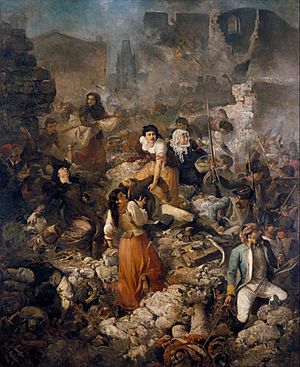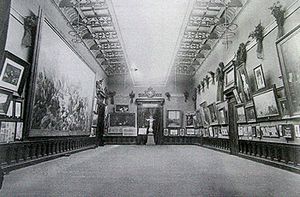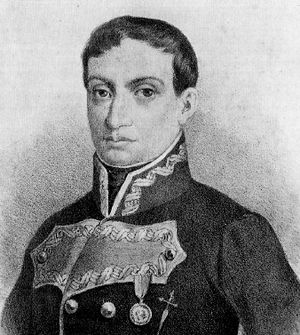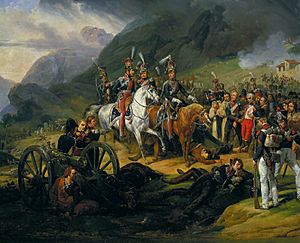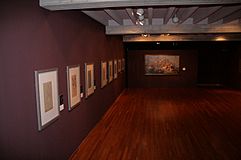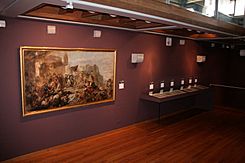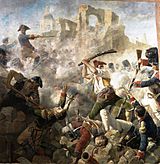The Great Day of Girona facts for kids
Quick facts for kids The Great Day of Girona |
|
|---|---|
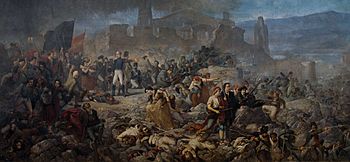 |
|
| Artist | Ramon Martí Alsina |
| Year | Date completed: 1863-64 |
| Medium | Oil on canvas |
| Dimensions | 496 cm × 1082 cm (16 ft 3 in × 35 ft 6 in) |
| Location | Museu d'Art de Girona, Girona |
The Great Day of Girona, also known as El gran dia de Girona in Catalan, is a huge oil painting by Ramon Martí Alsina. It shows a big victory for the defenders of Girona against the French army during the Third Siege of Girona in 1809. The painting was finished in 1864. It is the largest painting ever made on an easel in Catalan art history.
Creating this massive artwork took Martí Alsina over 10 years. It almost caused him serious money problems many times. Today, the painting is part of the Museu Nacional d'Art de Catalunya collection. It is shown permanently in Girona, inside a building of the Catalan Government.
Because the painting is so big, experts think Martí Alsina might have wanted to compete with another famous painting. This was Battle of Tetuan by Marià Fortuny. That painting was ordered by the city of Barcelona and was about the African War.
In 1938, during the Spanish Civil War, the painting was damaged. This happened when the building where it was displayed was bombed. To keep it safe, the artwork was rolled up and stored. Seventy years later, between 2009 and 2010, the painting was carefully restored.
Contents
The Story Behind the Painting
In the mid-1800s, paintings about history were very popular. They often showed local heroes and important national events. Martí Alsina wanted to become a famous painter across Spain. He was already a teacher at a well-known art school in Barcelona.
One way artists gained fame back then was by winning art competitions. The most important one was the National Exhibition of Fine Arts in Madrid. This competition often featured paintings about history, with exciting and dramatic stories.
Martí Alsina first entered this competition in 1858. He won a third-class medal for one of his works. Later that year, he showed another painting called "The Last Days of Numantia." The government bought it for a lot of money and gave it to the Prado Museum. In 1860, he won a second-class medal for a landscape painting.
Martí Alsina spent much of his life painting about the Guerra del Frànces (the Peninsular War) and the Siege of Girona. He created works like El somatent del Bruch and The Heroines of Girona. His most famous work from this time is The Great Day of Girona. This painting took him many years to finish.
How the Painting Was Made
Some experts believe Martí Alsina chose to make such a huge painting to compete with Marià Fortuny's The Battle of Tetuan. Fortuny's painting was very successful across Europe.
Martí Alsina needed a very large space to work on his painting. He found a big studio called the "Casino de Sants." He brought in real armor, weapons, and historical items to make his painting as accurate as possible. He also used many models. He dressed them in special costumes made just for the painting.
Martí Alsina visited Girona many times. He made hundreds of sketches of the city. Some of these sketches are now in private collections. Others are kept at the Museu Nacional d'Art de Catalunya (MNAC) and the Museum of Art Girona.
Martí Alsina started working on the painting around 1859. A letter from Girona in October 1859 confirms this. The letter was a reply to his questions about flags and other details. He wanted the painting to look as real as possible.
He ordered a frame for the painting in March 1864. This suggests he planned to send it to the National Exhibition of Fine Arts that year. However, his friends gave him some critical feedback. So, he decided to keep working on it. He never signed the finished painting. It stayed in his studio until he died.
Years later, Martí Alsina used his research and sketches for other paintings about the Siege of Girona. These included Heroines of Girona (shown in 1868) and The Company of Saint Barbara (shown in 1891).
Personal papers show that Martí Alsina used The Great Day of Girona to get a loan. He owed a lot of money to a person named Pau Borrell. Since he couldn't pay back the loan, Borrell temporarily owned the painting. In 1894, Martí Alsina made a deal with Borrell's family. He got the painting back by trading 14 other artworks for it. A newspaper article from that time said Martí Alsina then tried to sell the painting to the City Council of Barcelona.
What's in a Name?
The Great Day of Girona is the most common name for the painting. It's also the name used in the museum's catalog. However, it is sometimes called The Defenders of Girona.
The name "The Great Day of Girona" likely came from Colonel Blas de Fournàs. He described the events of September 19, 1809, as "the great day of Girona." More than 1,000 people died on that day. In some of Martí Alsina's own notes, he called the painting The Defenders of Girona or even The Painting of Girona.
Damage from Bombing
After Martí Alsina died in 1894, a collector named Joan Nepomucè Font i Sangrà bought The Great Day of Girona. He offered to show it at an art exhibition in Barcelona. The painting was first shown in 1898 as part of an exhibition honoring artists who had recently passed away.
After this, the painting was moved to different museums in Barcelona. In 1904, it was still in storage. Font i Sangrà wondered why it wasn't being shown. The director of the Museum of Fine Arts explained that the painting was too big. It was rolled up and stored to protect it.
In 1905, Font i Sangrà took the painting back. Because of its size, he hung it in a special chapel on his property. The Great Day of Girona became a tourist attraction there. Font i Sangrà enjoyed showing it to visitors.
In 1929, the painting became the property of the City Council of Barcelona. It was then put on permanent display in the Palace of Fine Arts. When the MNAC museum was created in 1934, many artworks were moved there. But very large paintings, like The Great Day of Girona, stayed at the Palace of Fine Arts.
In 1938, during the Spanish Civil War, the Palace of Fine Arts was used for meetings. That summer, the building was bombed. Its roof was destroyed. This caused damage to The Great Day of Girona, including cracks over five meters long. After the war, it was decided that the painting would be rolled up and stored at the MNAC for its protection. This was until it could be restored. The restoration work began in 2009.
Bringing the Painting Back to Life
To celebrate 200 years since the French War and the 1809 Siege of Girona, the Museum of Art, Girona, planned a special exhibition. They asked to borrow The Great Day of Girona from the MNAC. But first, the painting needed to be restored.
This restoration project was a team effort. It involved the MNAC, the Catalan government's Department of Culture, and the Museum of Art, Girona. A foundation called Caixa Girona provided the money. Before this, the painting had been stored for over seventy years. It was only unrolled once in 1998 to be photographed while being moved.
The First Look
On September 14, 2009, a team of experts began to unroll the huge canvas. This happened in the Oval Hall of the National Palace in Barcelona. They carefully inspected the painting.
For three days, they studied the painting's condition. They looked at both the front and back of the canvas. They used special tools to see tiny details of the materials. They also took small samples for chemical tests.
They took many photos using different techniques, like ultraviolet light. They also researched other paintings from the same time. This helped them understand the condition of The Great Day of Girona. Because the painting was so big, it was saved from some common but more invasive restoration methods. These included techniques like relining (adding a new canvas backing) or general varnishing.
Restoration in Valldoreix
The restoration work was done in Valldoreix. It was the first project of its kind in Catalonia because of the painting's huge size. The restorers used Martí Alsina’s old notes and photos of the painting from before it was damaged in 1938.
Before starting, they did scientific studies. They analyzed samples of the paint and varnish. They also used special cameras to see layers beneath the surface. Experts from a university helped analyze the canvas fabric. The whole process was carefully documented and photographed. The goal was to do as little as possible to the original painting.
The team divided the work into phases because of the painting's size. They started with the back of the canvas. They found a large tear, almost 7 feet long. They carefully sewed it up, thread by thread, using special glue.
Then, they cleaned the front of the canvas in two steps. First, they removed dust. Second, they used a special gel to remove deeper dirt. Any areas where paint was missing were filled in with a special putty. This restoration is considered a great example of how to restore large artworks.
Finding a New Home in Girona
The restored painting was moved on September 14, 2010. It went directly from the restoration center to the Josep Irla Auditorium in Girona. This auditorium is in the Old Hospital of Santa Caterina.
The painting was transported by truck. A team of eight people carefully unloaded it. Restorers and other experts watched closely. A special metal frame was built to hold the painting. This frame will also make future care easier. The staff at the Museum of Art, Girona, now controls the temperature and lighting for the painting.
The exhibition of the painting officially opened on October 23, 2010. In 2012, Google Art Project chose the painting to be photographed for their online platform.
What the Painting Shows
The Great Day of Girona is 496 cm tall and 1082 cm wide. This makes it larger than other famous paintings like Battle of Tetuan by Fortuny and Guernica by Pablo Picasso. The painting was made on a single piece of canvas, with no seams. It weighs about 70 kg. Experts think the fabric might be the same type used for boat sails.
The painting shows what happened after a battle on September 19, 1809. This was during a seven-month siege of Girona by the French army. The city's defenders fought back under the command of General Álvarez de Castro.
You can see the towers of the Girona Cathedral and St. Felix church in the background. The city walls and Gironella Tower are in the front. Martí Alsina chose to show the battle in an area called La caserna dels Alemanys. This allowed him to show a classic view of Girona and a place where other important battles happened.
Martí Alsina is often compared to artists like Courbet and realism painters. He brought realism to Catalonia. However, The Great Day of Girona is more like Romanticism.
Martí Alsina's painting style is similar to the French historical painter Horace Vernet. Both artists made many sketches from different angles. This helped them show large groups of people in their final works.
Martí Alsina had seen an exhibition in 1855. There, he saw historical paintings by Vernet, Ingres, Delacroix, and Alexandre Gabriel Decamps.
The painting is divided into three main parts. The figures closest to you are the most realistic and dramatic. They are painted with brighter colors. The figures in the middle are less clear. Those in the background are only hinted at and seem to blend into the buildings, like in a fog.
The right side of the painting forms a pyramid shape. The top of the pyramid is in the ruined background. The left side of the pyramid is made by the defenders. This creates a diagonal line that draws your eye to the military figures.
The group of figures on the left side shows the last line of the city's defenders. General Alvarez de Castro is clearly shown among them.
The way the painting is put together is similar to Vernet’s Battle of Somosierra from 1812. In that painting, the mountain in the background frames the figures on horseback. This creates a contrast with the wounded figures in the front.
In the bottom part of The Great Day of Girona, which is the front of the battle scene, you see wounded and dead people. These images are very realistic and dramatic. One figure in the center, below the General, is a woman. She is like the female figures in Martí Alsina’s other work, The Company of Saint Barbara. She represents women who helped the wounded in battle. She wears a red ribbon on her left arm, showing she is an aide. You can see other similar female helpers. Some are assisting the injured, while others are giving out food and drinks.
On the far right, you can see the French Army retreating. Their figures are blurred. This makes them less important in the painting.
Where to See the Painting
The painting has been shown publicly in two main places. The first was the Palace of Fine Arts in Barcelona. It was displayed there in 1898 as part of an exhibition honoring artists who had recently passed away. Since June 8, 2011, the History Museum of Girona has displayed one of Martí Alsina’s drawings for The Great Day of Girona.
The Anatomy of a Painting
After the painting was restored and moved, a special exhibition was held. It was called "Ramon Martí Alsina. The Great Day of Girona. Anatomy of a Painting." It ran from October 23, 2010, to May 29, 2011. The exhibition explored why the painter created this work. It was held in three locations in Girona:
- Josep Irla Auditorium: This is where the main painting is now permanently displayed.
- Plenary Hall of the Council of Girona: This space permanently shows ‘Heroines of Girona’, another painting by Martí Alsina.
- Museum of Art Girona: This museum displayed sketches and drawings that Martí Alsina made while preparing for the painting.
Other Versions of the Story
Many artists have painted about the siege of Girona. There are several other versions of this historical event:
- The Museum of Art Girona has a smaller version of the painting. It is called The Siege of Girona 1809 or Study for the Great Day of Girona (1860). Martí Alsina painted and signed this smaller version himself.
- César Álvarez Dumont (1866–1945) painted his own version of the siege in 1890. It has the same title as Martí Alsina’s work, The Great Day of Girona. It is now in the collection of the Prado Museum in Madrid.
- Laureà Barrau painted Surrender of Girona, 1809 in 1884. This painting is now in a private collection in Girona.
See also
 In Spanish: El gran día de Gerona para niños
In Spanish: El gran día de Gerona para niños


